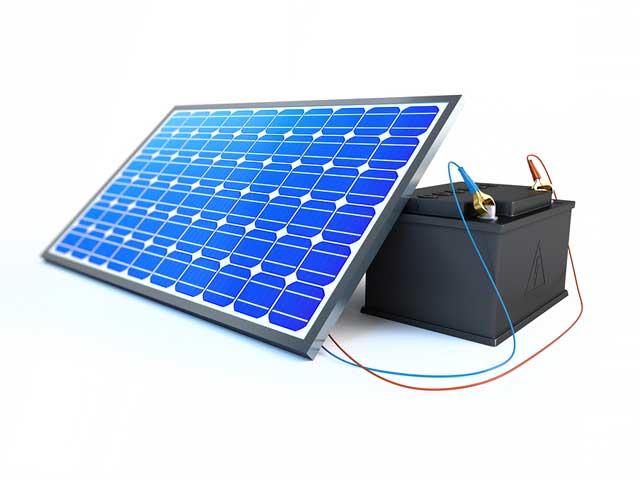More evidence emerged this week of the imminent arrival of the solar storage revolution. First was a report by the Deutsche Bank, the latest to predict that solar will become the dominant energy source by 2050, displacing other traditional energy such as fossil fuels.
“Over the next 20 years, we expect the electricity market to double to $US4 trillion and expect the solar industry to increase by a factor of 10. During this timeframe, the solar industry is expected to generate $5 trillion of cumulative revenue,” said the report.
The study sees solar expanding rapidly in developing countries such as India.
“By the year 2050, we expect global solar penetration rates to increase to 30%. We also see solar penetration rates increasing more rapidly in developing economies. India for example has recently announced targets to reach 100GW of solar capacity by 2022.”
The solar storage revolution
But it is affordable solar storage which the bank describes as being at the heart of the revolution. Calling it the “next killer app” because it will help with metering and accessing the grid, the bank states the importance of storage in the rapid expansion of solar power.
“We believe reduction(a) in solar storage costs could act as a significant catalyst for global solar adoption, particularly in high electricity markets such as Europe.”
Reinforcing the was an ABC article last week which quoted CQUniversity professor Peter Wolfs as saying his team was researching ways for people with solar power to access stored energy during natural disasters. As the recent cyclones in the North have shown, the loss of power is a major problem for those affected by these natural disasters.
However Professor Wolfs said it was possible for those with solar energy to disconnect from the grid during such times, thanks to solar energy and storage.
“You can separate your house. If you actually disconnect your house from the network during a power outage you can form what is called an island and you basically operate off your solar energy and your energy stored in a battery.”
Calling the falling price of the storage battery for electric cars the real “gamechanger”, he predicted that further drops in price will encourage more homeowners to add a battery component to their solar system.
“…the price of batteries has dropped steadily at about 10 to 15 per cent each year, so in a handful of years, three to four years, you’ll probably find there will be an increasing demand for batteries going into houses.”
So all signs point to a solar storage revolution at the vanguard of solar energy as the dominant power source of the future. The opportunities for Australia, with its wide open spaces and wealth of sunlight, are of course, endless. The chance to become a true renewable energy superpower (as Australia was once described by the Spanish Foreign Minister) may lie in investment in not just solar energy, both domestic and large array, but also in solar battery storage.


 RSS - Posts
RSS - Posts



I thoroughly agree with all your points. Battery technology, dead for over a century has at last started to grow wings due to the need for mobile storage. Started with laptop computers and power tools and now driven (no pun int.) by the electric car. Tesla in particular. We are seeing an order of magnitude efficiency growth maybe 2. Who knows where it will end, look at computing power.
Excellent comment thanks Duncan. Agree with what you say, the PV technology and battery storage revolutions seem to started at different points, though as you say, the needs of modern technology has now given battery technology a huge boost. Sky’s the limit!
Hi Rich,
Well, it is clear that our governments don’t want people to have solar power. May I suggest that households install solar this way: preferably with micro inverters, but string inverters will do, use a changeover switch in order to isolate from the grid, use a small battery bank of say 6 @ 12 volts, 2 in series and 3 parallels, use a 2400 Watt pure sine wave inverter, 50 Amp, 50 Hz,,, and use a relay driver with several voltage settings outputs. That is inverter, batteries, relay driver. You can use the dc from one panel via a Y connector from + & – to the 24 VDC input on the inverter, this will charge the batteries and by that it will determine the voltage for the relay driver which is powered from the battery bank. The relay driver outputs will be for e.g. voltage 12 volt switch over to solar, > 14 Volt switch over to Hot water heater and any other voltage in between the battery extremes. That way you can expand your battery bank on your system to eventually be complete grid free. There are a few Zero Export devices on the market, but they just waste electricity by ceasing your inverter to export, thus the panels are sitting on the roof doing nothing. Enphase is marketing an AC battery which I believe will be on the market later this year, whether or not it will cheaper than my suggestion remains to be seen. There is a good video on Youtube.com by Mark Kash “Grid tie inverter without a grid. I wouldn’t use his homemade illegal change over switch though. Use only SAA approved electrical equipment. You can design the system yourself but have it installed by your electrical contractor.
John Nielsen, Silkwood, Qld.
Thanks John. Great thinking!